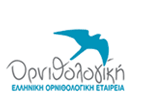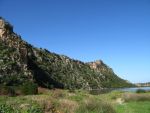|
GR122 Evrota delta
 |
 |
Criteria: A4i, B1i, C2
Coordinates:
36o 49' N
22o 43' E
()
|
Altitude: 0-100 m
Area: 3000 ha
|
|
 |
 |
Images
Site Description
A delta with dunes, saltmarshes, riverine vegetation, meadows and reedbeds ( Phragmites ).
 |
 |
Habitats: Artificial landscapes (Arable land; Other urban and industrial areas; Perennial crops, orchards and groves), Coastline/rocky areas (Sea cliffs and rocky shores), Grassland (Dry siliceous grassland), Sea/marine area (Sea inlets and coastal features), Shrubland (Sclerophyllous scrub, garrigue and maquis), Wetland (Coastal lagoons; Fens, transition mires and springs; Mud flats and sand flats; Rivers and streams; Salt marshes; Sand dunes and beaches; Tidal rivers and enclosed tidal waters; Water fringe vegetation)
Land use: agriculture (50%), fisheries/aquaculture (5%), nature conservation and research (10%), tourism/recreation (10%), urban/industrial/transport (5%), water management (50%)
|
 |
 |
Protection status
National None International None
2350 ha of the IBA are covered by Special Protection Area (SPA) YGROTOPOI EKVOLON EVROTA(GR2540006).
Birds
The area is important for passage waterbirds and passerines, and for breeding and passage raptors. Species of global conservation concern that do not meet IBA criteria: Aquila clanga (wintering), Aquila heliaca (wintering), Falco naumanni (minimum 3 breeding pairs).
| Species | Season | Year | Min | Max | Acc | Criteria |
|---|
| Plegadis falcinellus Glossy Ibis | passage | 1997 | 500 | - | average | A4i, B1i, C2
|
|
Conservation issues
The major threats are the expansion of agriculture into wetland areas and tourism-related development. The area is a candidate SAC.
 |
 |
Threats:
abandonment/reduction of land management (low), agricultural intensification/expansion (high), aquaculture/fisheries (high), construction/impact of dyke/dam/barrage (medium), drainage (unknown), dredging/canalization (medium), filling-in of wetlands (medium), groundwater abstraction (high), industrialization/urbanization (low), infrastructure (medium), recreation/tourism (low), unsustainable exploitation (high)
|
 |
 |
Source:
Copyright © Hellenic Ornithological Society
|
|

Do you know the area?
Send us your comments at iba@ornithologiki.gr
If you have noticed serious damage to the area and you want to report it please click here
 
|




